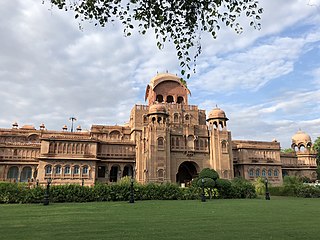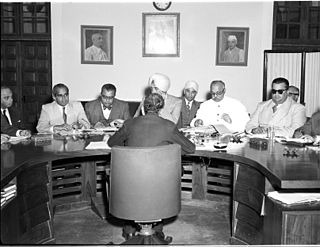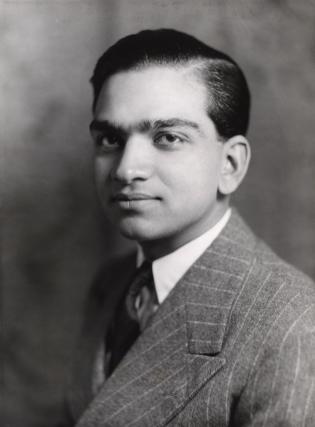
Jaipur is the capital and the largest city of the north-western Indian state of Rajasthan. As of 2011, the city has a population of 3.1 million, making it the tenth most populous city in the country. Located 268 km from the national capital New Delhi, Jaipur is also known as the Pink City due to the dominant color scheme of its buildings in old city.

Bikaner is a city in the northwest of the state of Rajasthan, India. It is located 330 kilometres (205 mi) northwest of the state capital, Jaipur. Bikaner city is the administrative headquarters of Bikaner District and Bikaner division.

Gayatri Devi was the third Maharani consort of Jaipur from 1940 to 1949 through her marriage to Maharaja Sawai Man Singh II. Following her husband's signature for the Jaipur State to become part of the Union of India and her step-son's assumption of the title in 1970, she was known as Maharani Gayatri Devi, Rajmata of Jaipur.

The Palace on Wheels is India's first luxury tourist train launched by the Indian Railways in joint collaboration with Rajasthan Tourism Development Corporation (RTDC) to promote tourism in Rajasthan. The train was launched in 1982. The train has been renamed as Heritage Palace on Wheels.

Rajpramukh was an administrative title in India which existed from India's independence in 1947 until 1956. Rajpramukhs were the appointed governors of certain Indian provinces and states.

Indira Devi was the Maharani of the princely state of Cooch Behar, British India. She was born a princess of Baroda as the daughter of Maharaja Sayajirao Gaekwad III, by his second wife Chimnabai II.

The Kachhwaha, or Kachhawa is a Rajput clan found primarily in India.

Cooch Behar, also known as Koch Bihar, was a princely state in India during the British Raj. The state was placed under the Bengal States Agency, part of the Eastern States Agency of the Bengal Presidency. It is located south of the Himalayan kingdom of Bhutan, in present-day West Bengal.
Gogunda is a town and tehsil headquarters of Gogunda Tehsil in Udaipur district, located about 35 km (22 mi) in north-west from Udaipur city in the Indian state of Rajasthan. It is situated on a high mountain in Aravalli hills and is reached by crossing a difficult mountain pass.

Major General Maharaja Sawai Man Singh II GCSI GCIE was an Indian prince, government official, diplomat and sportsman.

Brigadier Maharaja Sawai Bhawani Singh MVC was an officer in the Indian Army and an entrepreneur.
The Rambagh Palace in Jaipur, Rajasthan is the former residence of the Maharaja of Jaipur located 5 miles (8.0 km) outside the walls of the city of Jaipur on Bhawani Singh road.
Vishal Singh Rathore is a professional polo player from Rajasthan India, he is also known for his horse riding skills and polo pony training. He currently plays for Rajasthan Polo Club and has been the captain for the India national team 7 times.
Maharaja Sir Tej Singh Prabhakar, KCSI, was a ruler of Naruka dynasty of the Indian princely state of Alwar, Rajasthan from July 22, 1937 to 15 Aug 1947. Also, he was the last ruling Maharaja of Alwar.

The City Palace, Jaipur is a royal residence and former administrative headquarters of the rulers of the Jaipur State in Jaipur, Rajasthan. Construction started soon after the establishment of the city of Jaipur under the reign of Maharaja Sawai Jai Singh II, who moved his court to Jaipur from Amber, in 1727. Jaipur remained the capital of the kingdom until 1949—when it became the capital of the present-day Indian state of Rajasthan—with the City Palace functioning as the ceremonial and administrative seat of the Maharaja of Jaipur. The construction of the Palace was completed in 1732 and it was also the location of religious and cultural events, as well as a patron of arts, commerce, and industry. It was constructed according to the rules of vastushastra, combining elements of Mughal and Rajput architectural styles. It now houses the Maharaja Sawai Man Singh II Museum, and continues to be the home of the Jaipur royal family. The royal family has around 500 personal servants. The palace complex has several buildings, various courtyards, galleries, restaurants, and offices of the Museum Trust.The MSMS II Museum Trust is headed by chairperson Rajamata Padmini Devi of Jaipur. Princess Diya Kumari runs the Museum Trust, as its secretary and trustee. She also manages The Palace School and Maharaja Sawai Bhawani Singh School in Jaipur. She founded and runs the Princess Diya Kumari Foundation to empower underprivileged and underemployed women of Rajasthan. She is also an entrepreneur. In 2013, she was elected as Member of the Legislative Assembly of Rajasthan from the constituency of Sawai Madhopur.

Diya Kumari is an Indian politician from Bharatiya Janata Party currently serving as the 6th Deputy Chief Minister of Rajasthan alongside Prem Chand Bairwa in the ministry of Bhajan Lal Sharma. She currently represents Vidhyadhar Nagar as an MLA in the 16th Rajasthan Legislative Assembly. She is a member of the erstwhile royal family of the Jaipur State.

Shri Maharana Sir Bhupal Singh Bahadur KCIE, also spelt Bhopal Singh, was the ruler of the Indian princely state of Udaipur from 1930 and also Rajpramukh of Rajasthan from 1948 until his death on 4 July 1955.

Yaduveer Krishnadatta Chamaraja Wadiyar is a member of a former Indian royal family and the great-grandson of Maharaja Jayachamarajendra Wadiyar. He was adopted by Pramoda Devi Wadiyar, the wife of his great-uncle Prince Srikantadatta Wadiyar fourteen months after the latter's demise on 10 December 2013. Yaduveer Wadiyar was installed as the "Maharaja of Mysore" in a private ceremony in 2015.
Rajendra Prakash, K.C.I.E., 48th direct male lineal descendant from the original founder of the Dynasty, served as the Maharaja of Sirmur State from 1933 until 1964.

Padmini Devi is the titular Rajmata of Jaipur.















